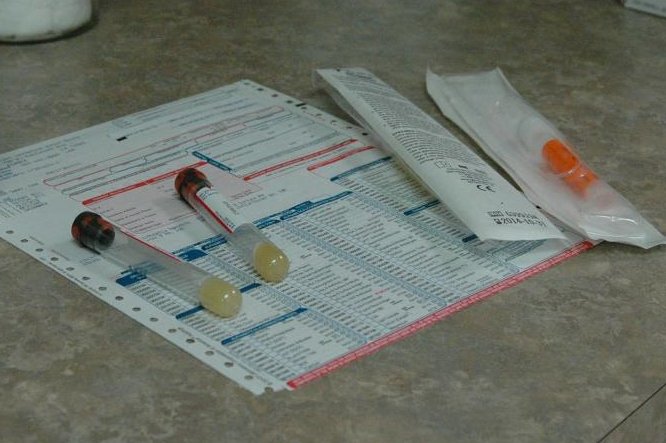A diabetes blood test may cost only $5, but about 50 percent of high-risk patients for prediabetes and diabetes are being missed because of current federal guidelines, researchers say. Photo by Creative Commons/Pixabay
April 24 (UPI) -- Current screening criteria might miss more than half of prediabetes and type 2 diabetes cases, even though a $5 blood test can diagnose the condition.
Dr. Matthew O'Brien, an assistant professor of medicine at Northwestern University's School of Medicine, found that the age and weight-based recommendations by the U.S. Preventive Services Task Force are missing certain racial and ethnic demographics, as well as other medical conditions. His findings were published earlier this month in the Journal of General Internal Medicine.
More than 30 million Americans have diabetes, with 90 percent to 95 percent of them having type 2 diabetes, according to the Centers for Disease Control and Prevention.
In 2015, USPSTF recommended that physicians screen patients for dysglycemia, which is prediabetes or type 2 diabetes, when they are 40 to 70 years old and are overweight or obese.
"A lot of those people, 103 million in the United States, are not being tested according to screening guidelines," O'Brien, who also an internist with the Northwestern Medical Group, told UPI. "Just following guidelines, they are not going to be tested if they are a middle-aged adult or not obese."
O'Brien worked with the Centers for Disease Control and Prevention to analyze data on 3,643 adults that was collected from the 2011 to 2014 as part of the National Health and Nutrition Examination Surveys -- and who said they didn't have diabetes.
"Most of those people not diagnosed have never been tested," O'Brien said. "Some people have gone to a doctor and said he said they didn't have diabetes 10 years ago. They think nothing about it. For all intents and purposes it probably means they don't think they have it."
Study participants received a blood test. The results revealed that 49.7 percent had undiagnosed abnormal blood glucose, which was diagnosed as an A1C of at least 5.7 percent, fasting blood glucose at least 100 mg/dL or 2-hour blood glucose at least 140 mg/dL.
Broken down by ethnicity and race, the rate of diabetes among participants was 48.6 percent among non-Hispanic whites, 54 percent among blacks, 50.9 percent among Hispanic/Latinos and 51.2 percent among Asians.
"There is a really big problem with these recommendations in terms of minority groups," O'Brien said. "Asians are missed. They develop diabetes at normal body weight."
And some African-Americans and Hispanics don't fall into the criteria. O'Brien said they develop diabetes at a young age. "Using guidelines of 40 years old, you are going to miss a lot of younger adults," he said.
If the criteria were expanded, the study found only 23 percent of patients with prediabetes or diabetes would be missed. The proposed expanded criteria includes a family history of diabetes, history of gestational diabetes or polycystic ovarian syndrome or non-white race or ethnicity.
"This seems like a no-brainer to screen patients who have any of these additional risk factors," O'Brien said in a press release. "By demonstrating how well these expanded criteria work in identifying patients with prediabetes and diabetes, we're proposing a better path for the USPSTF to strengthen its screening guidelines."
O'Brien said the USPSTF mentions deep into the guidelines that doctors could consider screening other high-risk groups.
"There is also an argument that maybe everyone should be screened," O'Brien said. "That's what it says for cholesterol."
If that's the case, the hemoglobin A1C test would be 100 percent covered under the Affordable Care Act in preventive exams. O'Brien estimates the test costs about $5, including drawing and analyzing blood, but medical providers and testing companies mark up the cost as much as $100.
"Testing all adults is more expensive for the healthcare system," O'Brien said.
"If we find people early and find they have a medical condition, we believe we save money down the road. The problem is the country's insurers and employers are footing the bill."
Diabetes is treated with healthier eating, exercise and medications. Otherwise, diabetes can lead to life-threatening complications such as heart attacks, strokes and kidney failure.
And O'Brien said that if the majority of those tested turn out to be negative, that's great because they'll know -- and those who have it will get treatment.
"The earlier patients are diagnosed with these conditions, the sooner they can begin to combat them," O'Brien said.















